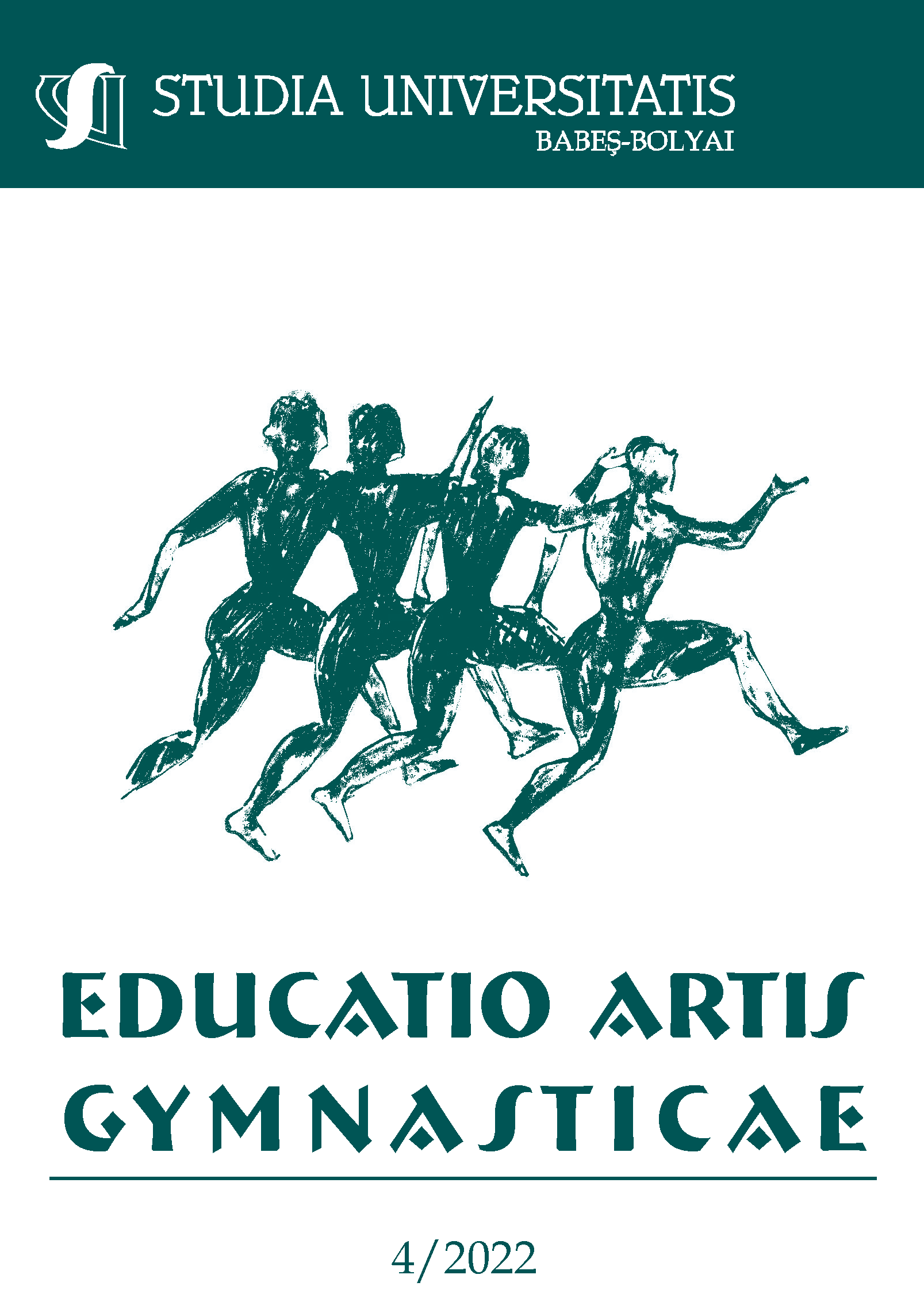THE INFLUENCE OF THE VISUAL ANALYZER ON POSTURE AND BALANCE – REVIEW TYPE STUDY
DOI:
https://doi.org/10.24193/subbeag.67(4).50Keywords:
visual impairment, posture, balance, visual analyzerAbstract
Introduction: The posture of the body in space is influenced by information from outside and inside the human body. The eye has a dual role being both an exteroceptor and an enteroceptor. Exteroception is achieved through peripheral vision and proprioception is related to the activity of the extrinsic muscles of the eyes and the oculo-cephalo-gyrus pathways. Therefore, the visual analyzer can influence the posture through refractive disorders (myopia, hypermetropia or astigmatism) or blindness, but also through convergence disorders and heterophoria. Purpose: The present study was carried out with the aim of analyzing the influence of the visual analyzer in maintaining the correct posture of the body. Material and method: Search engines Google Scholar as well as Frontiers, BioMed and ScienceDirect databases were searched using keywords on the desired topic and 53 articles were found. After inclusion criteria were applied (studies from the last 15 years, full articles, studies using cohorts of subjects or case studies), 20 articles were chosen for analysis. Results: In the 20 articles chosen for the study, blind participants were discussed, healthy subjects whose response to different visual stimuli was analyzed or subjects with different visual impairments who were investigated to maintain balance and correct body posture in different conditions. Conclusions: After analyzing the 20 articles, we came to the conclusion that the visual analyzer influences balance and can produce changes in body posture in space. Improving the function of the visual analyzer can be achieved through specific exercises, various surgical interventions or balancing performed by specialists such as aophthalmologist doctor, physiotherapist or posturologist.
References
Bricot, B. ( 2010). Posturologia Clinica, 1th edition, Sao Paulo: Cies Brasil.
Black, A. A., Wood, J. M., Lovie-Kitchin, J. E., & Newman, B. M. (2008). Visual impairment and postural sway among older adults with glaucoma. Optometry and vision science, 85(6), 489-497.
Bucci, M. P., Soufi, H., Villeneuve, P., Colleville, L., Bui-Quoc, E., & Lions, C. (2016). Importance of proprioceptive information for postural control in children with strabismus before and after strabismus surgery. Frontiers in systems neuroscience, 10, 67.
Caldani, S., Bucci, M. P., Tisné, M., Audo, I., Van Den Abbeele, T., & Wiener-Vacher, S. (2019). Postural instability in subjects with usher syndrome. Frontiers in Neurology, 830.
Castro, K. J. S., Salomão, R. C., Feitosa Jr, N. Q., Henriques, L. D., Kleiner, A. F. R., Belgamo, A., ... & Souza, G. S. (2021). Changes in plantar load distribution in legally blind subjects. PloS one, 16(4), e0249467.
Gaertner, C., Creux, C., Espinasse-Berrod, M. A., Orssaud, C., Dufier, J. L., & Kapoula, Z. (2013). Benefit of bi-ocular visual stimulation for postural control in children with strabismus. PLoS One, 8(4), e60341.
Haibach-Beach, P., McNamera, S., & Lieberman, L. (2020). Home-based balance pilot intervention for adults with visual impairments. British Journal of Visual Impairment, 0264619620935937.
Legrand, A., Quoc, E. B., Vacher, S. W., Ribot, J., Lebas, N., Milleret, C., & Bucci, M. P. (2011). Postural control in children with strabismus: effect of eye surgery. Neuroscience letters, 501(2), 96-101.
Lion, A., Haumont, T., Gauchard, G. C., Wiener-Vacher, S. R., Lascombes, P., & Perrin, P. P. (2013). Visuo-oculomotor deficiency at early-stage idiopathic scoliosis in adolescent girls. Spine, 38(3), 238-244.
Luo, H., Wang, X., Fan, M., Deng, L., Jian, C., Wei, M., & Luo, J. (2018). The effect of visual stimuli on stability and complexity of postural control. Frontiers in neurology, 9, 48.
Mohapatra, S., Krishnan, V., & Aruin, A. S. (2012). The effect of decreased visual acuity on control of posture. Clinical neurophysiology, 123(1), 173-182.
Palm, H. G., Strobel, J., Achatz, G., von Luebken, F., & Friemert, B. (2009). The role and interaction of visual and auditory afferents in postural stability. Gait & posture, 30(3), 328-333.
Park, D. J. (2016). Effect of visual stimulus using central and peripheral visual field on postural control of normal subjects. Journal of physical therapy science, 28(6), 1769-1771.
Rodrigues, S. T., Aguiar, S. A., Polastri, P. F., Godoi, D., Moraes, R., & Barela, J. A. (2013). Effects of saccadic eye movements on postural control stabilization. Motriz: Revista de Educação Física, 19, 614-619.
Sánchez-González, M. C., Gutiérrez-Sánchez, E., Elena, P. P., Ruiz-Molinero, C., Pérez-Cabezas, V., Jiménez-Rejano, J. J., & Rebollo-Salas, M. (2020). Visual Binocular Disorders and Their Relationship with Baropodometric Parameters: A Cross-Association Study. BioMed Research International, 2020.
Schwesig, R., Goldich, Y., Hahn, A., Müller, A., Kohen-Raz, R., Kluttig, A., & Morad, Y. (2011). Postural control in subjects with visual impairment. European journal of ophthalmology, 21(3), 303-309.
Soares, A. V., Oliveira, C. S. R. D., Knabben, R. J., Domenech, S. C., & Borges Junior, N. G. (2011). Postural control in blind subjects. Einstein (Sao Paulo), 9, 470-476.
Thomas, N. M., Bampouras, T. M., Donovan, T., & Dewhurst, S. (2016). Eye movements affect postural control in young and older females. Frontiers in aging neuroscience, 8, 216.
Tychsen, L., & Foeller, P. (2020). Effects of immersive virtual reality headset viewing on young children: Visuomotor function, postural stability, and motion sickness. American journal of ophthalmology, 209, 151-159.
Wiszomirska, I., Kaczmarczyk, K., Błażkiewicz, M., & Wit, A. (2015). The impact of a vestibular-stimulating exercise regime on postural stability in people with visual impairment. BioMed research international, 2015.
Zipori, A. B., Colpa, L., Wong, A. M., Cushing, S. L., & Gordon, K. A. (2018). Postural stability and visual impairment: Assessing balance in children with strabismus and amblyopia. PloS one, 13(10), e0205857.
Webography
Baritz, M.A. (2016), Dezvoltarea Conceptuală și aplicativă a analizelor bio-comporta-mentului uman în confort ocupațional și ambiental, [Teză de abilitare]. https://www.unitbv.ro/documente/cercetare/doctorat-postdoctorat/abilitare/teze-de-abilitare/baritz-mihaela/prezentare_teza_abilitare_Baritz.pdf, last accessed 4.10.2022.
Downloads
Published
How to Cite
Issue
Section
License
Copyright (c) 2022 Studia Universitatis Babeș-Bolyai Educatio Artis Gymnasticae

This work is licensed under a Creative Commons Attribution-NonCommercial-NoDerivatives 4.0 International License.






